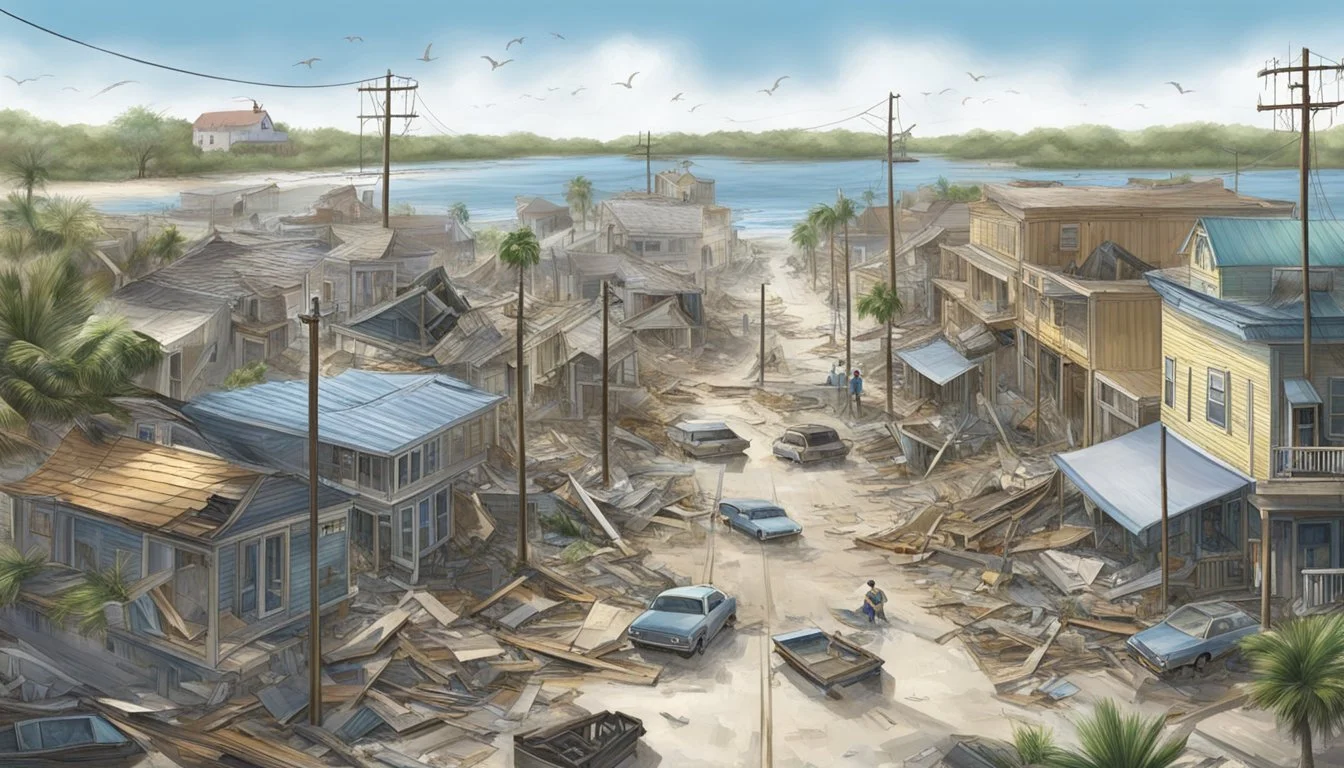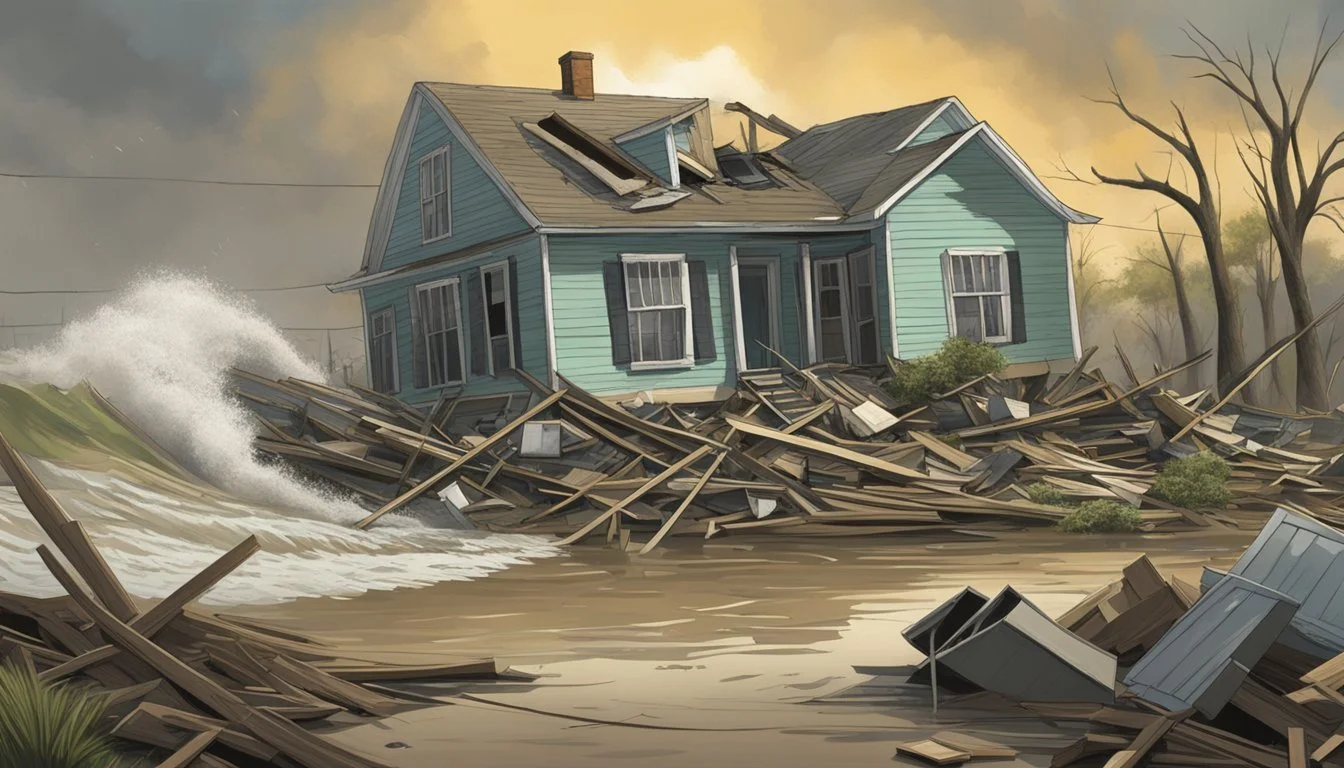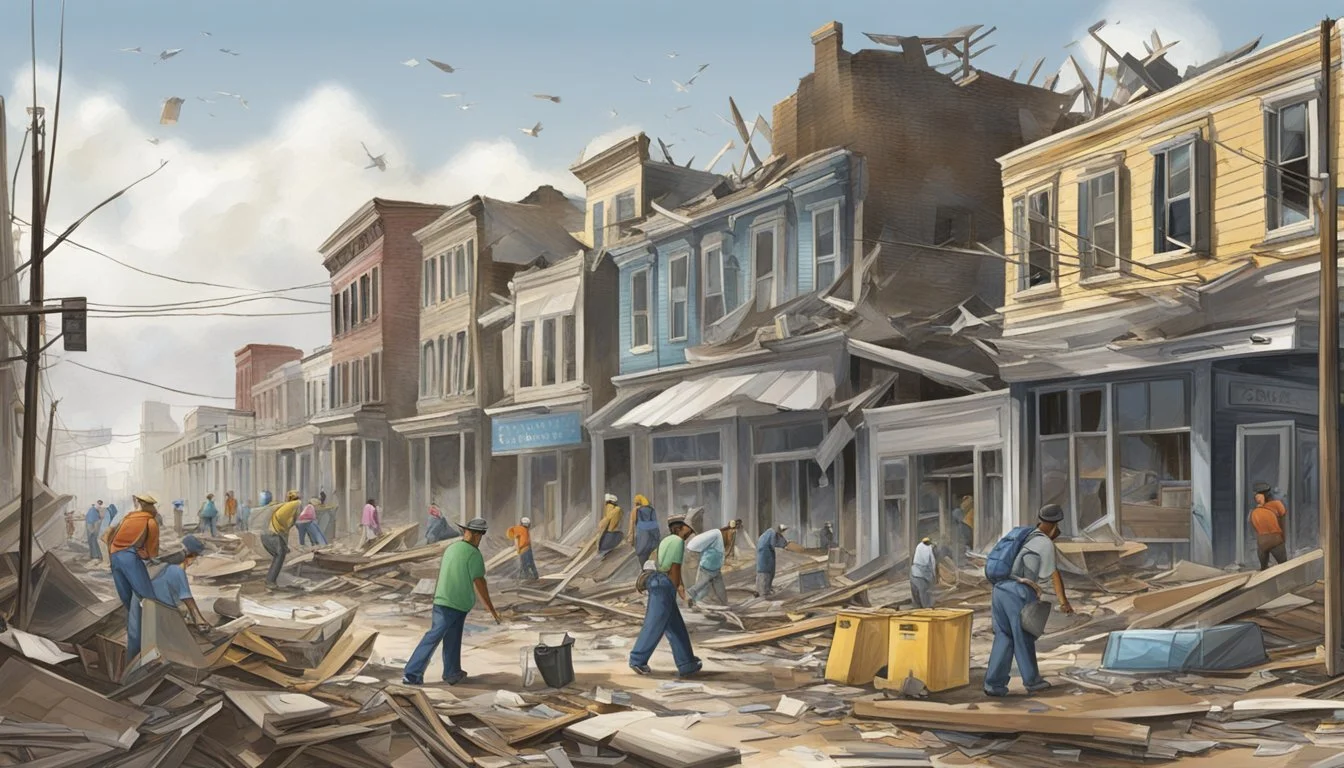6 Hurricane Ike Documentaries That Show Texas' 2008 Grit
Resilience in the Face of Disaster
Hurricane Ike slammed into the Texas coast on September 13, 2008, leaving a trail of destruction in its wake. The Category 2 storm brought winds of nearly 110 mph and caused an estimated $29.5 billion in damages. Six powerful documentaries capture the resilience and determination of Texans as they faced one of the most destructive hurricanes in U.S. history.
These films provide a gripping look at the impact of Hurricane Ike on communities along the Texas Gulf Coast. From Galveston Island to Houston, cameras rolled as residents prepared for the storm, weathered its fury, and began the long process of recovery. The documentaries showcase both the devastating power of nature and the indomitable spirit of those affected.
Filmmakers, including local students and professional crews, worked to preserve the stories of Hurricane Ike's survivors and first responders. Their efforts resulted in compelling narratives that blend personal accounts with striking imagery of the storm's aftermath. These six documentaries serve as a testament to Texas' strength in the face of adversity and offer valuable insights into disaster preparedness and community resilience.
The Devastation of Hurricane Ike
Hurricane Ike slammed into Texas on September 13, 2008, unleashing widespread destruction. The powerful Category 2 storm packed winds of up to 110 mph and a devastating storm surge.
Galveston Island bore the brunt of Ike's fury. The storm surge reached up to 20 feet, submerging large parts of the island. Homes and businesses were swept away or left in ruins.
In Houston, high winds toppled trees and power lines. Millions lost electricity, some for weeks. The city's downtown suffered significant flooding and damage to skyscrapers.
Ike's impact stretched far beyond the coast. The storm's massive size brought destructive winds and flooding inland, affecting a wide swath of Texas.
Key statistics on Hurricane Ike's devastation:
$30 billion in damage
112 deaths in the U.S.
3 million without power
100,000 homes flooded
Ike ranks as one of the costliest hurricanes in U.S. history. Its widespread damage served as a stark reminder of nature's power and the vulnerability of coastal communities.
Before the Storm: Warnings and Preparations
Hurricane Ike prompted extensive preparations along the Texas Gulf Coast in September 2008. Officials issued evacuation orders and cities mobilized resources as the massive storm approached.
Evacuation Orders and City Responses
Mandatory evacuation orders were issued for Galveston Island and low-lying areas of Houston on September 11, 2008. Officials urged over 1 million residents to leave coastal zones. Many cities opened emergency shelters and coordinated transportation for those without vehicles.
Police and fire departments increased staffing levels. Hospitals transferred critical patients inland. Schools and businesses closed as the evacuation got underway.
Gas stations experienced long lines as residents filled up before departing. Some ran out of fuel, complicating evacuation efforts.
Galveston and Houston Preparations
Galveston took extensive precautions, boarding up buildings and stockpiling emergency supplies. The city positioned high-water rescue vehicles and boats for post-storm operations.
Houston activated its emergency operations center and readied first responders. Crews cleared storm drains and secured loose objects that could become projectiles.
Both cities established evacuation hubs to assist residents without transportation. They coordinated with state officials to reverse highway lanes for smoother traffic flow out of coastal areas.
Residents in flood-prone neighborhoods sandbagged properties and moved valuables to higher ground. Many stocked up on non-perishable food, water, and batteries in case of extended power outages.
Hurricane Ike's Impact on Texas Gulf Coast
Hurricane Ike unleashed devastating flooding and destruction along the Texas Gulf Coast in September 2008. The massive storm surge and powerful winds caused widespread damage to coastal communities, with some areas experiencing catastrophic losses.
Extent of Flooding and Damage
Ike's enormous size generated a storm surge up to 20 feet high in some locations. This wall of water inundated large swaths of the Texas coast, flooding thousands of homes and businesses. Galveston Island saw extensive flooding, with many structures submerged up to their roofs.
Harris County sustained over $3.5 billion in damage from the hurricane. Wind gusts exceeding 100 mph toppled trees, power lines, and caused significant structural damage across the region. The Port of Houston, a critical economic hub, was forced to shut down for several days.
Over 2.6 million people lost electricity in Texas due to Ike's impact. Some areas remained without power for weeks following the storm.
High Island and Bolivar Peninsula
The Bolivar Peninsula bore the full brunt of Ike's fury. Storm surge completely overwashed this narrow strip of land, destroying nearly every structure. Only a handful of buildings remained standing after the hurricane passed.
High Island, situated on a salt dome, fared slightly better but still suffered extensive damage. Many homes were flooded or damaged by high winds. The community's water system was knocked offline for days.
The devastation on Bolivar Peninsula was so severe that some areas were deemed uninhabitable for months. Recovery efforts faced significant challenges due to the widespread destruction of infrastructure.
The Aftermath and Recovery Efforts
Hurricane Ike's devastation prompted massive cleanup and rebuilding efforts across Texas. Residents, rescuers, and government agencies worked tirelessly to restore communities and infrastructure in the storm's wake.
Roads to Recovery
The Coast Guard led initial rescue operations, saving thousands of stranded Texans. Cleanup crews cleared debris from roads and neighborhoods. Power companies worked to restore electricity to millions of homes. Governor Rick Perry mobilized state resources, declaring 29 counties disaster areas.
Rebuilding efforts focused on critical infrastructure like roads, hospitals, and schools. The state allocated $1.7 billion for housing recovery, though progress was slow. Five years after Ike, less than 3% of those funds had been spent. Only 36 new homes were built statewide in the first three years.
Community and Government Response
Local communities came together to support those displaced by the hurricane. Shelters provided temporary housing for thousands of residents. Volunteers and faith-based organizations offered food, supplies, and assistance with cleanup efforts.
FEMA established Disaster Recovery Centers to help survivors access aid and resources. The Texas General Land Office oversaw long-term recovery programs. Despite challenges, many communities showed remarkable resilience. Galveston, one of the hardest-hit areas, gradually rebuilt its infrastructure and economy.
Recovery efforts continued for years, with some areas still rebuilding a decade after the storm. The experience led to improved hurricane preparedness and coastal protection measures across Texas.
Personal Stories of Resilience
Hurricane Ike brought immense devastation, but also revealed the strength and resilience of Texas communities. Survivors, evacuees, and rescuers demonstrated remarkable courage in the face of adversity.
Survivors and Evacuees
Many residents chose to ride out the storm, facing harrowing experiences. John Smith, a Galveston local, described clinging to his roof as floodwaters rose around him. He was eventually rescued by boat after 12 hours.
Evacuees faced their own challenges. The Johnson family spent three days in gridlocked traffic trying to reach safety inland. They slept in their car and rationed food and water.
Photographer Sarah Lee documented the aftermath, capturing images of destroyed homes and displaced families. Her work highlighted the human impact of the disaster.
Rescue and Humanitarian Efforts
First responders worked tirelessly in dangerous conditions. Coast Guard teams rescued over 200 people from rooftops and flooded areas in the first 48 hours after landfall.
Local shelters quickly filled with displaced residents. Volunteers like Mark Davis organized food and water distribution, serving thousands of meals daily.
Power crews from neighboring states worked around the clock to restore electricity. Within two weeks, they had rebuilt large sections of the damaged grid.
Community members banded together to help neighbors clean up and rebuild. Church groups and local organizations coordinated crews to remove debris and repair homes.
Documenting Ike: The Role of Media
Media played a crucial role in capturing and preserving the impact of Hurricane Ike on Texas. Visual documentation and documentaries served as powerful tools to share the stories of affected communities and record this significant event in Texas history.
Photography and Visual Documentation
Photographers rushed to document the devastation wrought by Hurricane Ike in 2008. Their images provided immediate, visceral evidence of the storm's power and its effects on Texas coastal communities.
Professional and amateur photographers alike captured dramatic scenes of destruction, from flooded streets to demolished buildings. These visual records helped communicate the scale of the disaster to audiences far beyond the affected areas.
News outlets and government agencies used these images to illustrate the extent of the damage and the urgent need for assistance. The photographs also served as valuable resources for researchers and historians studying the storm's impact.
Documentaries as Historical Record
Documentaries about Hurricane Ike emerged as important historical records, offering in-depth explorations of the storm's aftermath and recovery efforts. These films provided a platform for survivors to share their experiences and for experts to analyze the event's long-term implications.
One notable example is the documentary created by students from Galveston's Ball High School. This project gave young filmmakers a unique opportunity to document their community's struggle and resilience firsthand.
Other documentaries focused on specific aspects of the disaster, such as environmental impacts or the challenges faced by particular communities. These films not only educated viewers about the hurricane but also preserved personal stories and local perspectives for future generations.
The Economic Impact of Hurricane Ike
Hurricane Ike wreaked havoc on the Texas economy in 2008, causing billions in damage and disrupting critical industries. The storm's effects rippled through oil refineries, local businesses, and the energy sector, leading to widespread economic challenges.
Oil Refineries and Local Businesses
Hurricane Ike forced the shutdown of numerous oil refineries along the Gulf Coast, significantly impacting fuel production. Nearly 20% of U.S. refining capacity was temporarily halted, causing gasoline shortages and price spikes nationwide. Local businesses in affected areas faced severe damage and prolonged closures.
Small enterprises struggled to recover, with many unable to reopen for weeks or months. The tourism industry took a major hit, as popular coastal destinations like Galveston suffered extensive destruction. Insurance claims skyrocketed, putting additional strain on the financial sector.
Challenges in the Energy Sector
The energy sector grappled with long-lasting effects from Hurricane Ike. Offshore oil and gas production in the Gulf of Mexico was severely disrupted, with platforms evacuated and drilling operations suspended. This led to a temporary decrease in domestic energy output and increased reliance on imports.
Power outages affected millions of customers, hampering economic activity across Texas. Utilities faced enormous costs to repair damaged infrastructure and restore service. The storm highlighted vulnerabilities in the energy grid, prompting discussions about improving resilience against future natural disasters.
Comparisons to Other Major Storms
Hurricane Ike's impact on Texas in 2008 drew comparisons to other devastating storms that struck the Gulf Coast. The destruction and recovery efforts paralleled those seen in Louisiana after Hurricanes Katrina and Rita.
Hurricane Katrina and New Orleans
Hurricane Katrina hit New Orleans in 2005, causing catastrophic damage. It claimed over 1,800 lives and displaced hundreds of thousands of residents. The storm surge breached levees, flooding 80% of the city.
Katrina's economic impact reached $125 billion, dwarfing Ike's $30 billion in damages. However, both storms exposed vulnerabilities in coastal infrastructure and disaster response systems.
New Orleans' population declined by over 50% immediately after Katrina. In contrast, Galveston saw a 20% population drop following Ike. Both cities faced long-term challenges in rebuilding homes, businesses, and communities.
Hurricane Rita and Its Effects
Hurricane Rita made landfall near the Texas-Louisiana border in September 2005, just weeks after Katrina. It caused significant damage to coastal areas and triggered one of the largest evacuations in U.S. history.
Rita's path through East Texas and Western Louisiana resulted in widespread power outages, similar to Ike. Over 1 million customers lost electricity during Rita, compared to 2.3 million in Ike's wake.
Both Rita and Ike highlighted the importance of effective evacuation plans. Rita's evacuation led to massive traffic jams and fuel shortages. Ike's approach prompted a more organized response, though some residents chose to shelter in place despite warnings.
Rita caused $18.5 billion in damages, less than Ike but still substantial. The storms underscored the need for improved building codes and infrastructure in hurricane-prone regions.
Federal and State Responses
The federal and state responses to Hurricane Ike demonstrated coordinated efforts to manage the crisis and support recovery. Key players included the Coast Guard, FEMA, and state leadership under Governor Rick Perry.
Role of the Coast Guard and Federal Agencies
The U.S. Coast Guard played a crucial role in Hurricane Ike response efforts. They conducted search and rescue operations, saving over 200 lives in the aftermath. FEMA mobilized resources and personnel to assist with emergency management.
Federal agencies provided critical support for evacuation, shelter, and recovery. President Bush declared a federal emergency, unlocking additional resources for Texas.
Governance and Leadership During Crisis
Governor Rick Perry took charge of state-level response efforts. He ordered mandatory evacuations for coastal areas, potentially saving thousands of lives. Perry also implemented a curfew to maintain order and safety in affected regions.
State officials coordinated with local authorities to establish shelters and distribute aid. They worked to reopen airports quickly to facilitate relief efforts and economic recovery.
The leadership faced challenges in balancing immediate rescue needs with long-term rebuilding goals. Communication between federal, state, and local entities proved crucial for effective crisis management.
Long-Term Effects and Lessons Learned
Hurricane Ike left an indelible mark on Texas history when it made landfall in 2008. The storm's devastating impact reshaped coastal communities and prompted significant changes in disaster preparedness.
Ike caused over $30 billion in damage, making it the most expensive hurricane in Texas history at the time. The widespread destruction forced many residents to rebuild their homes and businesses from scratch.
Debris removal and cleanup efforts continued for months after the storm. Local governments implemented new strategies for faster debris management in future disasters.
Key lessons learned from Ike include:
Improved evacuation procedures
Enhanced building codes for coastal structures
Better storm surge prediction models
Increased investment in flood mitigation infrastructure
The hurricane also highlighted the importance of community resilience. Texans demonstrated remarkable grit and solidarity in the face of adversity.
Long-term effects of Ike led to changes in emergency management practices. Officials now focus more on pre-disaster planning and public education about storm risks.
The experiences of Ike's victims informed new approaches to post-disaster recovery. Support systems for affected communities have been strengthened to address both immediate and long-term needs.





